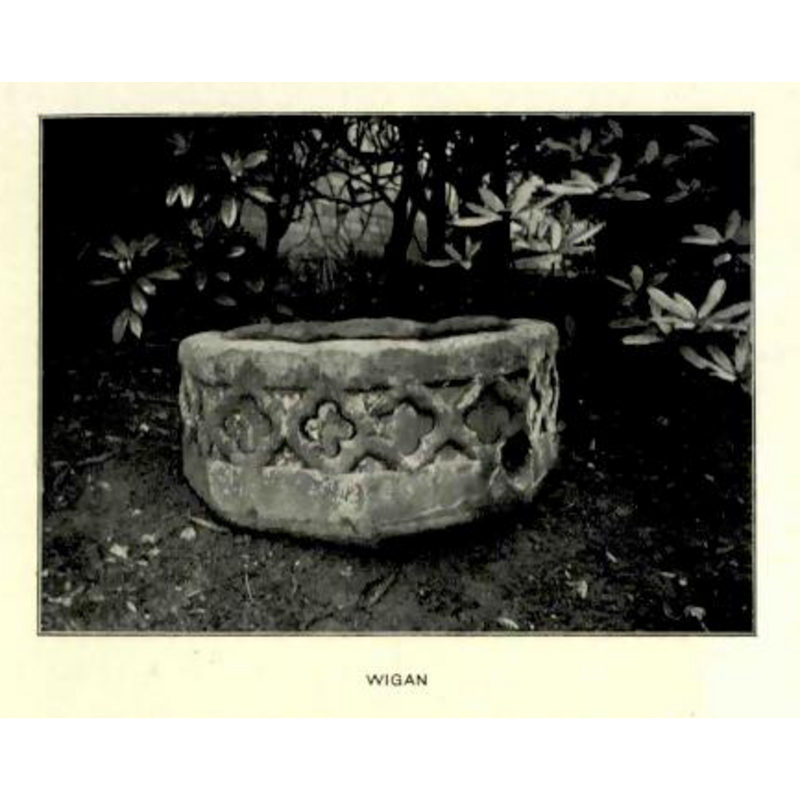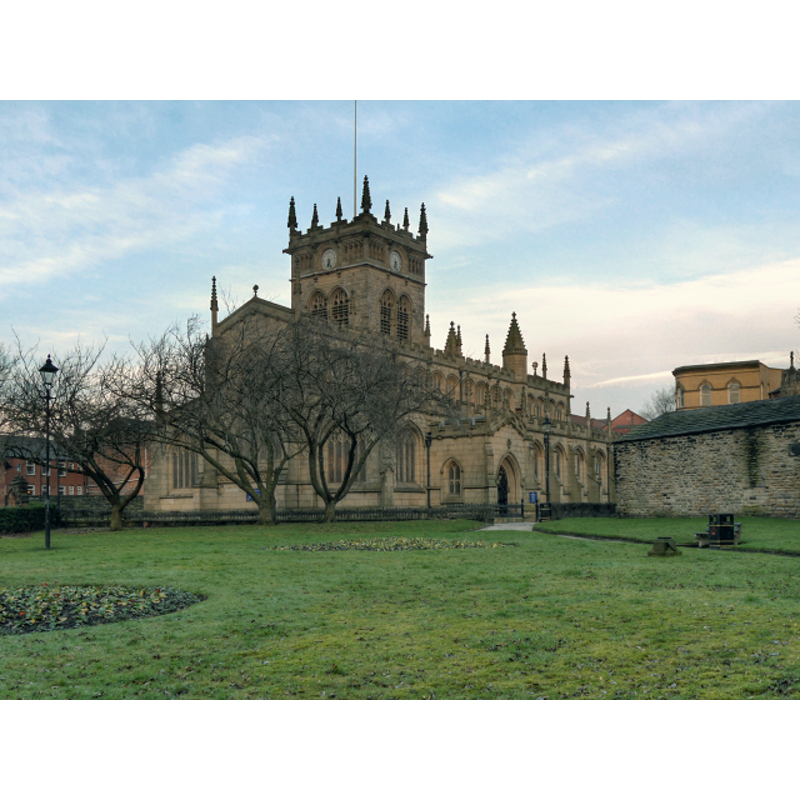Wigan No. 1 / Wygan / Wygayn

Image copyright © [in the public domain]
PD
Results: 4 records
design element - motifs - quatrefoil
view of basin
view of church exterior
view of font and cover
Scene Description: the modern font [cf. FontNotes]
Copyright Statement: Image copyright © Wigan Parish Church, 2013
Image Source: digital photograph in the Parish we site [www.wiganparishchurch.org/index_files/Page3348.htm] [accessed 3 February 2013]
Copyright Instructions: PERMISSION NOT AVAILABLE -- IMAGE NOT FOR PUBLIC USE
INFORMATION
FontID: 01551WIG
Object Type: Baptismal Font1 (fragment)
Church/Chapel: Parish Church of All Saints
Church Patron Saints: All Saints
Church Location: New Market St. Wigan, Lancashire WN1 1NL -- Tel.: +44 1942 244459
Country Name: England
Location: Lancashire, North West
Directions to Site: Located NW of Leigh, W of Bolton, 30 km WNW of Manchester
Ecclesiastic Region: Diocese of Liverpool
Historical Region: Hundred of Newton
Font Location in Church: [cf. FontNotes]
Century and Period: 14th century, Decorated
Church Notes: in its entry for Wigan the VCH (Lancaster, vol. 4, 1911) refers to the fact that in 1066 "'the church of the manor' of Newton had one ploughland exempt from all dues"; not clear how this reference relates to the church at Wigan, since Wigan does not have an individual entry in the Domesday survey. [NB: although the civil parish of Wigan was in the hundred of Newton [Neutone], several of its townships were in the hundred of West Derby, at least one of them, Aspull, later moved to the hundred of Salford
Font Notes:
Click to view
No individual entry found for Wigan in the Domesday survey, but it may have been accounted for under the hundred of Newton. Butterworth (1841) reports "an interesting font" in this church. Raines' annotated edition of Gastrell's 'Notitia cestriensis' (1845- ) reports: "The font, designed by Mr. Carpenter, architect, and sculptured by Mr. Thomas, sculptor to the new Palace of Westminster was presented to the church by the ladies above named" [i.e., "Misses Kenyon of Swinley of Wigan" et al.] Raines (ibid.) further notes that the original Norman (?) church "is said to have been destroyed by fire about the time of the Reformation". Listed in Cox & Harvey (1907) as a baptismal font of the Decorated period in the rectory garden. Ellis (1902) reports "the [D]ecorated or [P]erpendicular bowl of a font [...] [l]ying in the garden at Wigan Hall (the residence of the rector)" and the fact that an additional drainage hole "has been made near the lower edge of one of the ornamented faces, probably at the time when it was in use as a rain-water basin". The Victoria County History (Lancaster, vol. 4, 1911) notes in the entry for Wigan: "Though the plan of the church is ancient, the building has undergone even more than the general amount of renewal which has been the lot of so many of the neighbouring churches. [...] The tower is at least as old as the 13th century, and in the course of rebuilding some 12th-century stones are said to have been found. [...] The registers begin in 1580 [...] A font dating from c. 1710, removed from the church in 1850 is now in St. George's church, and the present font is modern", which accounts for the two post-1700 fonts [NB: the modern font is probably the one referred to in Raines [cf. supra], and in Lewis' Dictionary of 1848: "A beautiful font by Carpenter, of London, valued at a hundred guineas, has been presented by the Misses Kenyon", a donation that must have just taken place since the church opened in 1847]. A footnote in the same source (with source reference to the "Trans. Hist. Soc. (new ser.), xvii, 68), refers probably to the same object noted in Cox & Harvey [cf. supra]: "The octagonal bowl of a 14th-century font, used successively as a water trough and flower pot, lies in the garden of Wigan Hall". Pevsner (1969) does not mention the old unused basin at all. Pollard & Pevsner (2006) write: "Font. Fragment of the C14 or C15: an octagonal bowl with quatrefoil frieze." The Parish web site [www.wiganparishchurch.org/index_files/Page3348.htm] [accessed 3 February 2013] describes both the newer font and the recovered fragment of the 14th-century basin: "At the west end of the South Aisle, stands the Font. Originally it stood mid-way between the two western-most pillars of the Nave'on three great stayres' or steps, but unfortunately it was moved by Bishop Bridgeman in 1620' to a pillar on the south side of the middle aisle, near the west end of the church'. The font so removed was probably the octagonal 14th or 15th century one the bowl of which, restored to the church after serving for many years as a rain butt in the Hall garden, it still remains near the present font. The present font was made in 1912 by John Phillips, one of the sculptors employed on Liverpool Cathedral. Around the bowl are carved details of the instruments of the passion, including the whip, the crown of thorns and the nails, the cross and the ladder, and the hammers, pincers and dice. It is covered by a large ornately carved oak cover." [cf. Index entry for Wigan No. 2 for the font formerly at All Saints and later moved to St. George's -- we have no information on the font of the earlier church destroyed by fire]
COORDINATES
Church Latitude & Longitude Decimal: 53.545901, -2.632749
Church Latitude & Longitude DMS: 53° 32′ 45.25″ N, 2° 37′ 57.89″ W
UTM: 30U 524334 5933063
MEDIUM AND MEASUREMENTS
Material: stone, type unknown
Font Shape: octagonal (mounted)
Basin Interior Shape: round
Basin Exterior Shape: octagonal
Diameter (inside rim): 53.34 cm*
Diameter (includes rim): 68.58 cm*
Basin Total Height: 30.48 cm*
Notes on Measurements: * [in inches in Ellis (1902: 68)]
REFERENCES
Victoria County History [online], University of London, 1993-. Accessed: 2006-09-12 00:00:00. URL: https://www.british-history.ac.uk.
Bettley, James, Essex, New Haven and London: Yale University Press, 2007
Butterworth, Edwin, A statistical sketch of the County Palatine of Lancaster, Manchester: Longman & Co.; Banks & Co., 1841
Cox, John Charles, English Church Furniture, New York: E.P. Dutton & Co., 1907
Ellis, John W., "The Mediaeval Fonts of the Hundreds of West Derby and Wirral", LVIII (New series: XVII), Transactions of the Historic Society of Lancashire and Cheshire, 1902, pp. 59-80; p. 68
Lewis, Samuel, A Topographical Dictionary of England, Comprising the Several Counties, Cities, Boroughs, Corporate and Market Towns, Parishes, Chapelries, and Townships, and the Islands of Guernsy, Jersey, and Man, with Historical and Statistical Descriptions [...], London: S. Lewis, 1831
Pollard, Richard, Lancashire: Liverpool and the South-West, New Haven, London: Yale University Press, 2006

![the modern font [cf. FontNotes]](/static-50478a99ec6f36a15d6234548c59f63da52304e5/others/permission_not_available.jpg)